

Url?sa=t&rct=j&q=&esrc=s&source=web&cd=6&ved=0CDUQFjAFahUKEwiw9LW_7JnJAhWL7RQKHehYBoo&url= Tactile visualisations: Inuit wood maps. A theme of steadily increasing interest to me and many others in the field right now is the ideal of physical data visualisation.
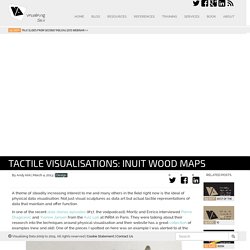
Not just visual sculptures as data art but actual tactile representations of data that maintain and offer function. In one of the recent data stories episodes (#17, the vodpodcast), Moritz and Enrico interviewed Pierre Dragicevic and Yvonne Jansen from the Aviz Lab at INRIA in Paris. They were talking about their research into the techniques around physical visualisation and their website has a great collection of examples (new and old). One of the pieces I spotted on here was an example I was alerted to at the NYC data viz meetup back in November and it motivated me to write about it here.
In Mark's presentation he recreated the clever way Bill Buxton introduces this design solution in his great book 'Sketching User Experiences' (pages 33-37). I can't remember word for word how Mark did it but it was along the lines of Bill's approach so I'll paraphrase that: Heatherwick Studio. The process of metal spinning is traditionally used to make circular metal objects, such as timpani drums and gas cylinders, by pressing flat sheets of metal against a shaped former while they both rotate.
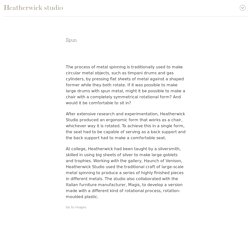
If it was possible to make large drums with spun metal, might it be possible to make a chair with a completely symmetrical rotational form? And would it be comfortable to sit in? After extensive research and experimentation, Heatherwick Studio produced an ergonomic form that works as a chair, whichever way it is rotated. To achieve this in a single form, the seat had to be capable of serving as a back support and the back support had to make a comfortable seat. At college, Heatherwick had been taught by a silversmith, skilled in using big sheets of silver to make large goblets and trophies. Decorative Plates. Mona Hatoum - Magasin III. Mona Hatoum: Grater Divide. For her exhibition at White Cube Hoxton Square British artist Mona Hatoum presented a body of new works.
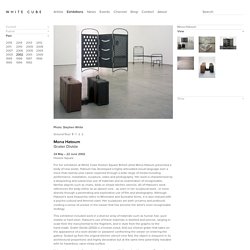
Hatoum has developed a highly articulated visual language over a more-than-twenty-year career explored through a wide range of media including performance, installation, sculpture, video and photography. Her work is characterised by a disquieting and subversive use of materials and an examination of recognisable, familiar objects such as chairs, beds or simple kitchen utensils. All of Hatoum's work references the body either as an absent core - as seen in her sculptural work - or more directly through a penetrating and explorative use of film and photography. Although Hatoum's work frequently refers to Minimalist and Surrealist forms, it is also imbued with a psycho-cultural and feminist slant. Her sculptures are both uncanny and profound, creating a sense of unease in the viewer that has become the artist's most recognisable strategy. 1. Overview L5 PIC. Crafts Reading List. General Coatts, Margot, ed.
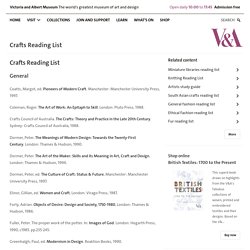
Pioneers of Modern Craft. Manchester: Manchester University Press, 1997. Coleman, Roger. The Art of Work: An Epitaph to Skill. Crafts Council of Australia. Dormer, Peter. Dormer, Peter. Dormer, Peter, ed. Elinor, Gillian, ed. Forty, Adrian. Fuller, Peter. Crafts_Council_Local_Report_Web_SinglePages.pdf. Download & Streaming : Images. NM_SlowArt_digital_fix_eng. 45932_file.pdf. Elongated_Intimacy_HANSON_Maria. What is Craft? Cinderella Table, Jeroen Verhoeven, 2005.
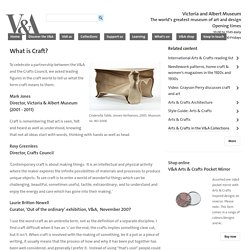
Museum no. W.1-2006 To celebrate a partnership between the V&A and the Crafts Council, we asked leading figures in the craft world to tell us what the term craft means to them. Mark Jones Director, Victoria & Albert Museum (2001 - 2011) Craft is remembering that art is seen, felt and heard as well as understood, knowing that not all ideas start with words, thinking with hands as well as head. Rosy Greenlees Director, Crafts Council 'Contemporary craft is about making things. Laurie Britton-Newell Curator, ‘Out of the ordinary’ exhibition, V&A, November 2007 'I use the word craft as an umbrella term, not as the definition of a separate discipline.
Caroline Broadhead Practitioner 'What craft means to me is the making part, the how you make, and this is an exchange with materials - what you give to a material, and what it gives back. Christopher Frayling. Saatchi Art Artist: Lynne Abrahamson; Fabric 2012 Painting "Baby Book"